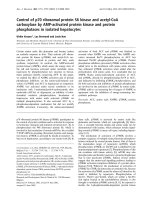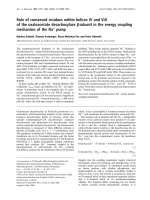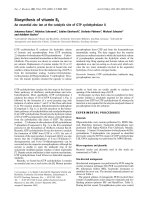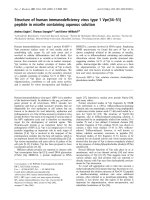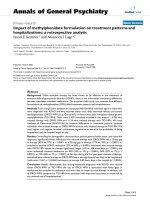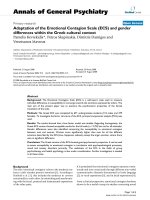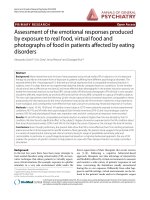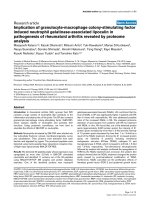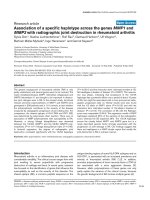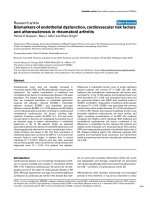Báo cáo y học: "Distribution of airway narrowing responses across generations and at branching points, assessed in vitro by anatomical optical coherence tomography" docx
Bạn đang xem bản rút gọn của tài liệu. Xem và tải ngay bản đầy đủ của tài liệu tại đây (2.62 MB, 12 trang )
RESEARC H Open Access
Distribution of airway narrowing responses across
generations and at branching points, assessed in
vitro by anatomical optical coherence
tomography
Peter B Noble
1*
, Robert A McLaughlin
3
, Adrian R West
2
, Sven Becker
3
, Julian J Armstrong
3
, Peter K McFawn
2
,
Peter R Eastwood
4,5,6
, David R Hillman
5,6
, David D Sampson
3
, Howard W Mitchell
2
Abstract
Background: Previous histological and imaging studies have shown the presence of variability in the degree of
bronchoconstriction of airways sampled at different lo cations in the lung (i.e., heterogeneity). Heterogeneity can
occur at different airway generations and at branching points in the bronchial tree. Whilst heterogeneity has been
detected by previous experimental approaches, its spatial relationship either within or between airways is
unknown.
Methods: In this study, distribution of airway narrowing responses across a portion of the porcine bronchial tree
was determined in vitro. The portion comprised contiguous airways spanning bronchial generations (#3-11),
including the associated side branches. We used a recent optical imaging technique, anatomical optical coherence
tomography, to image the bronchial tree in three dimensions. Bronchoconstriction was produced by carbachol
administered to either the adventitial or luminal surface of the airway. Luminal cross sectional area was measured
before and at different time points after constriction to carbachol and airway narrowing calculated from the
percent decrease in luminal cross sectional area.
Results: When administered to the adventitial surface, the degree of airway narrowing was progressively increased
from proximal to distal generations (r = 0.80 to 0.98, P < 0.05 to 0.001). This ‘serial heterogeneity’ was also
apparent when carbachol was administer ed via the lumen, though it was less pronounced. In contras t, airway
narrowing was not different at side branches, and was uniform both in the parent and daughter airways.
Conclusions: Our findings demonstrate that the bronchial tree expresses intrinsic serial heterogeneity, such that
narrowing increases from proximal to distal airways, a relationship that is influenced by the route of drug
administration but not by structural variations accompanying branching sites.
Introduction
Airways are structurally complex and in vivo are subject
to mechanical and physiological factors which potentially
lead to differences in the degree of narrowing in response
to a comparable provocative stimulus, often referred to
as airway ‘ heterogeneity’ . Structural and functional he t-
erogeneity, which impacts on normal respiratory func-
tion, could be present across different generations of the
bronchial tree, and notably at branching points where the
parent airway gives rise to daughter generations. There is
a need to better characterize airway heterogeneity as it is
thought to be important in the pathophysiology of
obstructive pulmonary disease [1,2].
The method used to measure airway narrow ing is cri-
tical to the identification of heterogeneity. Several stu-
dies based on direct imaging have compared the extent
of airway narrowing across different airways in the lung
[3-8], and nearly all reported some heterogeneity in
response to bronchoconstrictor challenge. Other studie s
* Correspondence:
1
Division of Clinical Sciences, Telethon Institute for Child Health Research,
(Roberts Road), Perth, (6008), Australia
Noble et al. Respiratory Research 2010, 11:9
/>© 2010 Noble et al; licensee BioMed Central Ltd. This is an Open Access article distribu ted u nder the terms of the Creative Commons
Attribution License ( which permits unrestr icted use, distribution, and rep roduction in
any medium, provided the original work is properly cited.
have used geometrical analyses of airway smooth muscle
(ASM) length in fixed airway tissue to assess pre-mor-
tem airway narrowing, and also report considerable het-
erogeneity amongst the airways sampled [9-12]. In
contrast, the degree of heterogeneity in airway responses
is not apparent from global measures of lung function
such as forced expiratory volume in 1 sec (i.e., FEV
1
)or
airway resistance, leaving the contribution from different
airway generations unknown.
Whilst heterogeneity in airway narrowing responses
has been frequently ob served, it remains unclear
whether the amount and rate of airway narrowing are
randomly distributed throughout t he lung, or whether
the response varies systematically along axial pathways,
such as may occur with a serially distributed heteroge-
neity. In vivo, narrowing increases from the trachea to
the major bronchi [8,13], presumably reflecting the tran-
sition from partial to more complete encirclement of
ASM in the airway wall. Imaging of isolated airway or
lung preparations either shows greatest narrowing in the
smallest diameter airways [7] or in mid-sized airways
[14] while histological studies identify large airways as
the site of greatest narrowing [10,11]. Some of the
incon sistencies and uncertainties in reports of het eroge-
neity are likely rel ated to methodological complexities
and limitations. In some studies for instance, aerosol
deposition of bronchoconstrictor agonists could produce
variable levels of ASM activation between airways
[11,12] thereby influenci ng the relationship between air-
way narrowing and generation. Moreover, previous ima-
ging and histological approaches provide information on
bronchoconstriction only in a single cross sectional
plane of selected airways, rather than o n the three-
dimensional (3D) response of contiguous parts of the
bronchial tree needed to provide a comprehensive and
reliable assessment of airway narrowing.
In contrast to heterogeneity between different airway
generations, the potential for more localised physiologi-
cal variability at the branching points of airways appears
to have been overlooked. The structural design at the
bifurcation deviates from the rest of the airw ay reflected
by differences in the shape and size of cartilage plates as
well as the orientation of ASM fibres [15-18]. Despite
this structural complexity at branching regions it is
unknown whether airway narrowing differs compared to
the main body of an airway.
This study determined the distribution of airway nar-
rowing along a part of the bronchial tree comprising a
series of contiguous conducting airways spanning a
range of airway generations, including associated side
branches. To measure changes in airway calibre we used
a recent optical imaging technique, anatomical optical
coherence tomography (aOCT), that incorporat es a
moving (rotating and translating) probe and so enables
the airway to be viewed across a predetermined distance
such that the organ is imaged essentially in three dimen-
sions. Unlike all previous studies, aOCT enabled
dynamic narrowing responses of different generations of
airway and side branches, in the same preparation, to be
recorded contemporaneously and under identical experi-
mental conditions. Specifically we recorded airway nar-
rowing to carbachol, in a portion of the bronchial tree
that was separated from the lung parenchyma so that
any differences could be attributed to the properties of
theairwayaloneandnottosurrounding lung tissue.
Carbachol was chosen as the agonist since regional dif-
ferences in narrowing or the kinetics of response are
independent o f enzymatic breakdown. By adding carba-
chol directly to the fluid bathing the adventitia or lumen
of the airways, we were also able to control the route of
drug delivery and the doses to which the ASM was
exposed.
Methods
Animal Handling
All animal experiments were approved by institutional
ethics and animal care un it. Eight White Landrace pigs
(30 ± 2 Kg), were sedated with tiletamine/zolazepam
(4.4 mg/Kg im.) and xylazine (2.2 mg/Kg im.) and
exsanguinated under pentobarbitone sodium anesthesia
(30 mg/Kg iv.). Lungs were then removed and trans-
ported on ice to the laboratory for dissection of airways.
Airway Preparation
A length of the bronchial tree was dissected from the
right lower lobe of the lung, beginning from the lobar
bronchus and extending dist ally ~5-6 cm. In the pig
lung, the first 6-7 cm of bronchus comprises a large par-
ent bronchus that runs axially with minimal bending,
giving rise to daughter airways (side branches) at regular
intervals (i.e., monopodial branching). The daughter air-
ways are smaller than the parent bronchus and typicall y
branch off with a high angle of departure. As each side
branch was reached it was cleared of parenchyma over a
distance of ~1 cm and ligated at a distance furthest
from the parent bronchus. Airway generation was deter-
mined by counting th e number of side branches arising
from the parent bronchus, taking the trachea as genera-
tion #0. The dissection produced a straight, tapering
and cylindrical bronchial tree s panning generations #1
to #13. A 3D ren dering of an airway preparation imaged
with aOCT is shown in Figure 1.
Airway preparations were cannulated at both ends and
placed horizontally in an organ bath containing gassed
(95% O
2
,5%CO
2
) Krebs solution (mM: NaCl 121; KCL
5.4; MgSO
4
1.2; NaHCO
3
25; sodium morpholinopro-
pane sulphonic acid buffer 5.0; glucose 11.5; and CaCl
2
2.5) at 37°C. The preparation was stretched slightly to a
length shown previously to approximate functional
Noble et al. Respiratory Research 2010, 11:9
/>Page 2 of 12
residual capacity in the pig lung, i.e., ~105% of the fully
deflated length at 0 c mH
2
O [19]. Intraluminal pressure
was 5 cmH
2
O, set by the height of a reservoir contain-
ing Krebs solution connected at the distal side of the
preparation.
Anatomical Optical Coherence Tomography
Airway dimensions were measured using anatomical
optical coherence tomography (aOCT) [20-23]. During
aOCT imaging, low coherence near infra-red light is
emitted from an optical probe. The same probe is used
simultaneously to detect reflections of light from the
air-tissue interface of the lumen which allows the dis-
tance to the luminal surface to be determined by inter-
ferometry. By rotating the probe, a 2D axial image of
the lumen may be recon structed, and by precisely mov-
ing the probe backwards or forwards using a mo torized
translation stage, these axial images may be combined
intoa3Ddataset.AirwaymeasurementsusingaOCT
are calibrated to account for the refractive index of the
medium, e.g., air or liquid. Airway segments in the pre-
sent study were filled with Krebs solution which we
determined to have a refractive index of 1.37.
The aOCT system has an axial resolution (optical
coherence length in air) of 32.9 μm, and a minimum
beam waist of 100 μm occurring 6.6 mm from the
probe head. The depth of focus of t he probe was 11
mm. For the present study, the rotating aOCT probe
was encased in a transparent catheter (OD 2.2 mm).
The catheter was inserted into the airway lumen, begin-
ning at the cannula in the proximal end of the airw ay
and extended down to the internal edge of the distal air-
way cannula where it was locked in position. The airway
lumen was sealed by wrap ping silicon tape around the
catheter at its point of i nsertion at the proximal side of
the airway. The aOCT probe was rotated at ~0.8 Hz,
acquiring quantitative images of lumen cross sectional
area, which were displayed in real time on a computer
monitor. For 3D airway assessment, the probe was
slowly drawn back along the length of the airway
(referred to as a ‘pullback scan’ ), co nstructing a 3D
model of the airway (Figure 1) under specified condi-
tions described below.
Experimental Protocol
Before experimentation airway preparations were
allowed 1 hour to equilibrate to organ bath conditions
during which the lumen and adventitia of the prepara-
tion were regularly flushed with fresh Krebs solution.
Tissue viabil ity was confirmed by airway contractions to
electric field stimulation (60 V, 5-ms pulse width,
30 Hz) and acetylcholine ( ACh; 10
-3
M) followed by a
recovery period of at least 1 hour.
Airway narrowing was assessed across the full range of
generations incorporated in the airway preparation. Two
protocols were used to measure airway narrowing to the
bronchoconstrictor agent carbachol. In the first proto-
col, carbachol was administered to the adventitial sur-
face (outside) of the airway preparation with a final bath
concentration of ~1 × 10
-6
to 1 × 10
-5
M sufficient to
produce ~50% bronchoconstriction (decrease in luminal
cross sectional area, see below Analysis and Statistics).
Pullback aOCT scans were performed in the relaxed air-
way before the addition of carbachol to the bath and
then at 5, 15 and 30 minutes after carbachol, which
approximated the time course of bronchoconstriction
(see Results). The rate of pullback was 0.19 mm/sec. In
the second protocol, carbachol was applied to the lumen
(inside) of the airway. To achieve a comparable level of
bronchoconstriction the dose of carbachol administered
Figure 1 A 3D profil e of a porcine bronchial tree acquired by anatomical optical coherence tomography (aOCT). The major portion of
the bronchial tree comprises a large parent bronchus that gives rise to smaller daughter bronchi (i.e., side branches) that branch off at an
obtuse angle of departure. The figure shows the airway preparation in its relaxed state and after bronchoconstriction in response to carbachol.
Noble et al. Respiratory Research 2010, 11:9
/>Page 3 of 12
to the lumen (3 × 10
-4
M) was 30-300 fold greater than
that applied to the adventitial surface due to the high
integrity of the epit helial barrier [24]. Furthermore, as
the rate of narrowing to luminally applied drugs in pig
airways is typically greater than by advential drug appli-
cation [ 24], likely due to the relatively thin internal air-
way wall barrier, the pullback rate was increased to 0.68
mm/sec and scans performed at 2, 5, 8, 11 and 14 min-
utes after the addition of luminal carbachol. Pullback
scans were initiated from the distal side of the prepara-
tion which meant a systematic d elay in scanning of
proximal regions relative to distal regions. Due to the
different pullback rates, the proximal region o f the air-
way was scanned ~3 min later t han the most distal
point during adventitial carbachol application, whereas
with the luminal protocol in which scanning speeds
were greater the time interval was reduced to ~1 min.
At the conclusion of the experiment, airways were
fixedinthebath,frozeninTissueTekembedding
media and cr yo-sectioned for stai ning with a Servio
Stain kit (Royal Perth Hospital).
Analysis and Statistics
Luminal cross sectional area was measured at different
locations in airways before and after the addition of car-
bachol, and airway narrowing was calculated from the
percentage de crease in luminal cross sectional area .
Unless otherw ise stated, airway cross sect ional area was
measured by tracing an area around the lumen using
custom designed quantification software developed i n
the C++ language.
Three separate analyses were performed. For the first
analysis (Analysis 1), we compared airway narrowing
between generations, at sites located away from branch-
ing points (see schematic in Figure 2). The airway gen-
erations studied were i n the range of #3-11, although
due to differences in branching patterns between air-
ways, most notably points of dual side branches in some
airways, the number of measurements made in each air-
way was not always identical. Measurements were taken
along the airway preparation, avoiding regions closer
than 1 cm to the plastic cannula at either end of the air-
way to eliminate any restriction on narrowing by the
cannula insert.
In addition to assessing differences in airway narrow-
ing between generations, this study also determined
whether there were local inhomogeneities in narrowing
at regions of airway branching. Two additional analyses
were carried out to assess this effect: (Analysis 2) Airway
narrowing within the parent bronchus was measured at
the midpoint of branching, i.e., where the parent
bronchus was seen to open into a daughter side branch
(Figure 2), and this was compared to narrowing mea-
sured immediately proximal and distal to the branching
point. Effects of adventitial and luminally applied
carbachol were examined; (Analysis 3) Airway narrowing
within the ‘ mouth’ of daughter side branches was mea-
sured (Figure 2) and compared to narrowing within the
adjacent parent bronchus. In order to measure cross
secti onal areas in the ‘mouth’ of a daughter bronchus, it
was necessary to take into considerat ion the angle of
pitch at which the daughte r bronchus branche d from
the parent. This was achieved by constructing a 3D pro-
file of the airway preparation (Figure 1) using successive
2D images acquired by aOCT pullback scans. For each
daughter side branch, w e manually identified the opti-
mal oblique plane (relative to the parent bronchus) in
which to make the cross-sectional area measurements.
This was the plane containing the mouth of the daugh-
tersidebranch.Toeliminateerrorscausedbyany
change of angle between the rel axed and contracted air-
ways, this oblique plane was identified separately for
each aOCT acquisition. Effects of luminal carbachol
only were examined. VolView software (Kitware Inc.,
NY, USA) was used for 3D reconstruction of airways
and for the subsequent measurement of luminal cross
sectional area in parent and daughter bronchi.
Graphical presentation and statistical analyses of data
were achieved using Graphpad Prism (v4.03, GraphPad
Software, CA, USA) and Statistica (99 Edition, StatSoft
Inc., OK, USA). Airway narrowing at different anatomical
locations (e.g., different airway generations or at branching
points) was compared using two-way ANOVA and New-
man-Keuls post hoc analyses with anatomical location and
time as repeat measure variables. Time to 50% narrowing
was computed for both outsi de and inside applicat ion of
Figure 2 A schematic of the airway preparation indicating the
measurements performed. Indentified in the figure are the parent
bronchus and a connecting daughter bronchus (i.e., side branch).
The distal and proximal ends of the airway preparation are also
labeled. For the study, three separate analyses were performed:
(Analysis 1), narrowing in the parent bronchus was measured and
compared between generations (A, black line), away from regions of
branching; (Analysis 2), narrowing in the parent bronchus was
measured at the midpoint of branching, where the parent bronchus
was seen to open into a daughter side branch (B, dotted black line),
and it was compared to narrowing measured immediately proximal
and distal to the branching point; (Analysis 3), narrowing within the
‘mouth’ of daughter side branches was measured (C, grey line) and
compared to narrowing within the adjacent parent bronchus at the
same site (B).
Noble et al. Respiratory Research 2010, 11:9
/>Page 4 of 12
carbachol and used as an index of the rate of airway nar-
rowing. Maximal airway narrowing/time to 50% narrowing
(rate) in response to outside or inside application of carba-
chol were compared at proximal and distal locations using
two-way ANOVA and Newman-Keuls post hoc analyses,
with route of drug administration as a non repeat measure
variable, and anatomical location as a repeat measure vari-
able. Linear correlations between maximum narrowing
and time to 50% narrowing were computed using Pear-
son’s correlation analysis. Comparisons between airway
narrowing measured in connecting daughter-parent
bronchi were made using Student’s paired t-test. Data are
means ± standard error where N equals the number of
animals/airway preparations, or where stated, N refers to
the number of data poin ts (see Results). A P-value < 0.05
was considered statistically significant.
Results
Example cross sectional images of airways recorded by
aOCTareshowninFigure3.Thefigureshows2D
images of a proximal and distal airway before and after
the addition of carbachol to the adventitial surface. The
luminal surface of airways is indicated as well as the loca-
tion of the optical probe. The relaxed lumen diameter in
the most proximal airway (corresponding to generations
3-5) was 8.1 ± 0.3 mm (N = 8) and 6.0 ± 0.2 mm in the
most distal airway (generations 8-11). Subsurface struc-
tures such as cartilage plates are also detect able illustrat-
ing the potential of aOCT for airway wall measurements
such as wall thickness [23,25], though this function was
not evaluated in the present study.
Scans were acquired along the entire length of the air-
way preparation before and after carbachol and changes in
cross sectional area were measured until the narrowing to
carbachol had reached a minimum cross sectional area.
Airway narrowing to carbachol administered to either
adventitial or luminal surfaces produced a heterogeneous
pattern of airway narrowing, such that narrowing was
more pronounced at distal locations. Furthermore, there
was a close correlation between airway g eneration and
narrowing (Analysis 1) by the adventitial route in all pre-
parations investigated (Figure 4, N = 4). In comparison,
when carbachol was administered to the luminal surface
in a different set of four airways, heterogeneity in air way
narrowing between different generations was less pro-
nounced. Only one out o f four airways investigated
showed a significant relationship between airway narrow-
ing and generation: r = 0.91, 4 data points, NS; r = 0.34, 5
data points, NS; r = 0.52, 6 data points, NS; r = 0.82, 6
data points, P < 0.05.
As a result of the progressive increase in narrowing with
generation there were substantial differences in airway
narrowing to carbachol in the most distal airway com-
pared to the most proximal, irrespective of the route of
drug administration (Figure 5A and 5B). Accordingly,
when carbachol was administered adventitially, the maxi-
mum reduction in lumen area was 55.4 ± 10.8% in the dis-
tal airway, and 36.0 ± 11.5% in the proximal airway
(P < 0.05, N = 4). Added to the luminal surface, the maxi-
mum reduction in lumen area was 43.2 ± 7.5% and 22.1 ±
3.0% in the distal and proximal airway, respectively
(P < 0.01, N = 4). There were no differences in maximum
Figure 3 Cross sectional images recorded by aOCT in a proximal and distal airway. Proximal airway is Gen #3 and distal airway Gen #9.
The airway epithelium (AE), probe catheter (PR) and cartilage plates (CP) are indentified. The airway preparation was scanned initially in its
relaxed state and then 5, 15 and 30 min after addition of carbachol administered to the adventitial airway surface. Airway narrowing was
typically greater and more rapid in distal airways.
Noble et al. Respiratory Research 2010, 11:9
/>Page 5 of 12
narrowing responses between adventitial or luminal drug
administration.
The rate of airway narrowing also varied with airway
generation and was more rapid in distal than proximal
airways as indicated by negative correlations in the time
to 50% response for adventitial drug administration in
all four preparations investigated (Table 1). By that
route, the time to 50% maximum response was 9.2 ± 2.3
min at the furthermost distal airway, which was signifi-
cantly less than 19.0 ± 2.4 min recorded at the further-
most proximal airway (P < 0.01, N = 4). Although there
was a trend for faster narrowing to luminal carbachol in
distal airways, rates (i.e., 2.8 ± 0.7 min and 6.8 ± 0.8
min for distal and proximal airways, respectively) and
correlations were not statistically significant. As reported
previously [24], the rate of narrowing was greater when
carbachol was added to the luminal surface than to the
adventitial surface (P < 0.01).
In addition to the measurements of airway narrowing
at different genera tions within the parent bronchus
(as in Analysis 1 above), airway narrowing was also mea-
sured at regions where branching occurred. We assessed
whether structural variations at regions of branching
modified airway narrowing within the parent bronchus
Figure 4 Relationship between generation and airway narrowing to carbachol administered to the adventitial airway surface. Plots are
from four different airway preparations. Airway narrowing was quantified by the percentage decrease in luminal cross sectional area (% CSA).
Airway narrowing was increased at more distal locations indicated by positive correlations between narrowing and airway generation in each
preparation. Linear equations of best fit are indicated for each airway. (Pearson’s correlation analysis)
Noble et al. Respiratory Research 2010, 11:9
/>Page 6 of 12
itself (Analysis 2). Airway narrowing was measured in
the parent bronchus either side of the branching site,
and at the mid point where the parent bronchus opened
into the side branch (Figure 6A). For measureme nts at
branching sites, the process of manually tracing the air-
way lumen involved some interpolation due to the
opening of the side branch mouth. No differences in air-
way narrowing were observed at branching versus non
branching sites either when carbachol was added to
the adventitial (Figure 6B) or to the luminal surface
(Figure 6C).
A further an alysis was performed to compare airway
narrowing in the mouth or opening of daughter bronchi
and the parent bronchus (Analysi s 3). Daughter bronchi
(i.e., side branches) were rea dily visible on 3D recon-
structions of the a irway preparation (Figure 1). Airway
narrowing to carbachol was measured in a total of 21
parent and daughter bronchi from four airway prepara-
tions. The magnitude of airway narrowing measured in
daughter bronchi was the same as that measured in the
parent bronchus (Figure 7).
Finally, in order to identify possible structural properties
that may influence airway narrowing at regions of branch-
ing, histological cross sections of parent bronchi were
obtained at branching points (see example in Figure 8.).
The figure indicate s considerable thickeni ng of the carti-
lage at the junction between the parent and daughter
bronchus. Cartilage thickening was accompanied by an
apparent increase in ASM mass. To investigate the consis-
tency of this observation, we conducted a semi-qua ntita-
tive analysis in a random sample of seven side branches
from seven airways. In six of these bronchi both thicker
cartilage and increased ASM at the side branch were
scored, compared to the adjacent parent bronchus. One
bronchus showed little change in either cartilage or ASM.
In all seven airways, ASM was aligned obliquely at the side
branch in comparison to parent airway wall regions.
Discussion
aOCT provides a novel and advanced means of imaging
the airway lumen with sufficiently short acquisition times
to enable the spatial and temporal response to b roncho-
constrictor stimuli to be recorded. The scanning pullback
protocol of aOCT enables a large region of the airway to
be investigated es sentially in 3D, unlike other techniques
such as X-ray radiography and videoendoscopy that
Figure 5 Airway narrowing measured in the most dista l and
proximal airways within the bronchial airway preparation.
Airway narrowing was induced by carbachol administered to either
(A) adventitial (N = 4) or (B) luminal (N = 4) airway surface. Airway
narrowing was quantified from the percentage decrease in luminal
cross sectional area (% CSA). Airway narrowing recordings were
somewhat later in the proximal airway since aOCT scans were
initiated from the distal airway (i.e., proximal recordings occurred ~1
min and 3 min later for luminal and adventitial protocols,
respectively). Airway narrowing was greater in distal airways
irrespective of whether the drug was applied to the adventitial (P <
0.05) or luminal (P < 0.001) surface. (Two-way ANOVA).
Table 1 Correlation coefficients for airway generation
against time to 50% response
Adventitia Lumen
-0.89, P < 0.05, N = 5 -0.87, NS, N = 4
-0.76, P < 0.05, N = 7 -0.54, NS, N = 5
-0.86, P < 0.05, N = 6 -0.71, NS, N = 6
-0.97, P < 0.001, N = 7 -0.56, NS, N = 6
Data are from eight different airway preparations that were constricted to
carbachol administered either to the adventitial or luminal airway surface.
Time to 50% response of airway narrowing was used as an index of the rate
of airway narrowing and was plotted against airway generation. When
carbachol was administered to the adventitial surface time to 50% response
was negatively correlated with airway generation indicating a faster rate of
narrowing at distal locations. In comparison, when carbachol was added to
the luminal surface correlations were not significant. N = number of data
points available for each individual airway. (Pearson’s correlation analysis)
Noble et al. Respiratory Research 2010, 11:9
/>Page 7 of 12
produce2Dimagesatsinglelocationsintheairway.In
applying aOCT to the study of airway physiology we have
demonstrated relationships between airway stimulation
and the dynamic response at defined, identifiable and con-
tiguous regions of the bronchial tree across a wide range
of generations ~3 to 11. Importantly, we investigated
regional airway narrowing in more depth than has pre-
viously been undertaken, including narrowing at side
branches, which even in the face of known structural dif-
ferences at these regions [15-18], has not been reported
elsewhere. The study shows a progressive increase in air-
way narrowing from the proximal to dis tal airway, a rela-
tionship that was influenced by the route of drug
administra tion but not by structural variations accompa-
nying branching sites.
Despite many studies endeavoring to characterize the
distribution of airway narrowing responses throughout
the lung, the regional distrib ution of such responses has
still not been clearly defined. Whilst some studies report
the greatest narrowing in proximal airways [10,11],
others report it in more distal generatio ns [7] or some-
where in between [14]. It is likely that most of these
inconsistencies can be attributed to methodological
complexities or limitations. For example n arrowing
responses in central versus peripheral a irways could be
influenced by variations in the deposition of broncho-
constrictor drugs [11,12] and by uncertainty in the ana-
tomical relationships be tween large and small diameter
airways [3-7]. In light of these shortcomings, an inten-
tion of the present study was to assess anatomical
Figure 6 Airw ay narrowing wit hin the paren t bronchus at branching sites. (A) Cross sectional images of a relaxed parent bro nchus at a
branching site and immediately proximal and distal to the branching site. The parent bronchus opens out to the daughter airway at the centre
of the branching site. Airway narrowing to adventitial (B, N = 4) and luminal carbachol (C, N = 4) was compared at the three locations identified
in (A). There was no difference in narrowing of the parent bronchus between branching or non branching sites irrespective of whether
carbachol was administered to the adventitial or luminal surface. (Two-way ANOVA).
Noble et al. Respiratory Research 2010, 11:9
/>Page 8 of 12
variations in the intrinsic narrowing capacity of airways
using an experim ental design that ensured different air-
way generations were assessed under identical mechani-
cal and physiological conditions. A range of identifiable
airway generations were imaged within a short time
window, which allowed narrowing responses in those
generation s to be recorded almost concurrently, thereby
establishing both a spatial and temporal relationship of
response. The isolated airway preparation was free of
parenchymal attachments and had a standardized trans -
mural pressure (pre and afterload) and volume history
so that differences could be attributed to the intrinsic
properties of the airway alone. Our findings suggest that
peripherally, airways become intrinsically more respon-
sive to cholinergic stimulation, broadly confirming ear-
lier reports in pig bronchi in vitro in which airway
narrowing was measured endoscopically in separate
large and small diameter airways [7]. The present study
extends these findings by documenting narrowing over a
wide range of identified inte rconnecting airway genera-
tions. We show that static and dynamic narrowing
responses to carbachol administered to the airway
adventitia correlate specifically to contiguous and
defined airway generations, i.e., airway narrowing within
the bronchial tree exhibits serial heterogeneity.
In separate experiments we also examined airway nar-
rowing responses to carbachol administered to the airway
lumen which replicates the physiological condition in pro-
vocation testing. Although heterogeneity was also shown
with luminal carbachol, it was less pronounced than expo-
sure via the adventitia, particularly generation by genera-
tion, suggesting t hat the intrinsic r esponse of the airway
wall was suppressed or regulated by some property of the
epithelium or mucosa. Note that when drugs are adminis-
tered via the adventitia, there is unhindered access to the
ASM. In contrast, when administered through the lumen,
tight junctions in the epithelium are impermeable to con-
tractile drugs such as carbachol [24] and, as a result, the
epithelial barrier wil l strongly regulate airway narrowing.
It was for this reason that we used a higher concentration
ofcarbacholinthelumenthanadventitiainorderto
obtain a comparable level of bronchoconstriction. The
precise mechanisms whereby the epithelium or mucosa
might regulate the expression of the intrinsic heterogene-
ity to luminal activation are not clear. However, we sug-
gest that the perme ability of the epithelium is potentially
Figure 7 Comparison of airway narrowing in parent and
daughter bronchi. Airway narrowing was measured in response to
luminally applied carbachol in the mouth of a daughter side branch
and in the parent bronchus at the branching site. A total of 21
parent-daughter branching sites were measured from four different
airway preparations. There was no difference in airway narrowing
between parent and daughter bronchi. (Paired t-test).
Figure 8 A histological cross section of a parent bronchus at a point of branching. The entire cross section of the bronchus is shown (Left
panel, Whole Airway) indicating the point at which the parent bronchus opens out into the daughter. The parent bronchial wall (PW) and the
wall at the shoulder of a branching point (BP) are indicated by arrows. Middle and right panels are magnified images of the branching point
and of the parent bronchial wall respectively. Substantial thickening of the cartilage plate (CP) at the branching point is apparent, which is
accompanied by an increase in smooth muscle (SM) mass and a more oblique orientation of muscle cells.
Noble et al. Respiratory Research 2010, 11:9
/>Page 9 of 12
important in this respect by regulating airway constrictor
responses and the dis tribution of airway narr owing
throughout the lung.
In this study airway narrowing in different airway gen-
erations was measured in response to a single dose o f
carbachol. Under these conditions, differe nces in airway
narrowing to bronchoconstrictor stimuli could reflect
differences in sensitivity and/or reactivity, the two broad
determinants of airway responsiveness. Separation of
these variables requires the construction of complete
dose response curves, which is impracticable even using
aOCT. Intrinsic differences in ASM sensitivity to carba-
chol would principally det ermine airway sens itivity,
whilst differences in ASM mass or stress and the load
against which ASM shortens could regulate the d egree
and rate of narrowing [26]. In the present study, we
favor the latter explanation of a shift in airway reactivity
as the source of heterogeneity because the sensitivity
and stress of isolated ASM to cholinergic agonists is
very similar in bronchi and bronchioles in this species
[27,28]. Furthermore, a previous study demonstrated
greater maximum narrowing to acetylcholine in small
diameter pig airways than in large [7]. Whilst future stu-
dies are required to identify the precise mechanism
responsible for variations in the degree and rate of nar-
rowing demonstrated in this study , th ere may be differ-
ences in the mechanical properties/behavior of the
airway wall between generations. The airway wall is a
multilayered structure comprising mucosa, ASM and
cartilage with fibroelastic connections between the layers
and each is stressed in response to bronchoconstrictor
stimulation [7,29,30]. Airway narrowing will be subject
to their respective elastic moduli and these may vary at
different locations within the bronchial tree and produce
the serial heterogeneity observed in the present study.
Based on the relationship between airway narrowing
and generation observed here, we would predict that air-
way closure would only occur, if at all, in the most per-
ipheral airway generations. Airway closure in vivo will of
course have significant physiological consequences,
including lung hyperinflation, an increa sed work of
breathing and an impaired gas exchange, all of which
occ ur in obstructiv e respiratory disease (asthma). While
airway closure was not observed in this study, it is
important to appreciate that flow may well be reduced
to physiologically unsustainable levels prior to absolute
airway closure, that is ‘functional closure’[7]. Moreover
any relationship between airway narrowing and genera-
tion could change considerably in disease as a result of
inflammation and airway w all remodeling [31], mani-
fested by a change in the slope of t he relationship or
perhaps a shift in the point of airway closure to more
proximal lung generations [32]. However there are also
several other factors that will influence the relationship
between airway narrowing and generation, most notably
ASM activation, which in the present study was approxi-
mately half that possible with exogenous carbachol. The
relationship between airway narrowing and generation
could further vary with other modes of stimulation to
those investigated h ere, for example, airway narrowing
induced by parasympathetic nerves, which will depend
on the distribution and density of nerve endings. In an
early study by Cabezas and colleagues [33], bronchocon-
striction to vagal stimulation showed greater responses
to stimulation in smaller airways than large, possibly for
the above reason, or as favored by the present study,
due to other intrinsic differences between small and
large airways. Finally, differences in branching pattern
and airway wall composition between species will likely
impact on the distribution of airway narrowing
responses to ASM activation.
Previous attempts have been made to identify serial
heterogeneity within the bronchial tree. However, to our
knowledge no study has determined whether more loca-
lized heterogeneity exists at side branches. Indeed,
branching points might have been considered an obsta-
cle to be avoided in past studies. By constructing both
2D and 3D images, we provide the first information on
narrowing at the entrance of the dau ghter airway and
whether the presence of a side branch affects narrowing
in the parent trunk. The results of the analysis have
shown that branching has no major effect on airway
narrowing; responses were uniform both within the
trunk of the parent airway and in the entrance, or
mouth, of an emerging side branch. Given the structural
complexity of branching, which requires a transition in
ASM orientation and cartilage, each of which could
potentially affect airway narrowing, these findings are
somewhat surprising. In the monopodial airway of the
pig, and other species, daughter airways emerge from
the parent trunk and the predominant circumferential
orientation of ASM in the parent re -orientates around
the daughter [17,18], which might reduce circumferen-
tial active stress in both parent and daughter. Saddle-
like plates of cartilage support the structural division
[15,16] and the additional mechanical load might be
expected to restrict airway narrowing [34,35].
A number of explanations can be offered as to why
airway narrowing is maintained at regions of branching.
One may be that the structural comple xity at the divid-
ing point is too localized to exert an o verall effect on
airway function, e.g., active ASM stress from neighbor-
ing parts of the airway prevails over any lack of stress at
the bifurcation. Importantly, a strength of our approach
was that we preserved the 3D structural i ntegrity of the
airway wall so that the physiological behavior of the
entire airway wall could be determined. Secondly, a
semi-quantitative analysis of airways used in the present
Noble et al. Respiratory Research 2010, 11:9
/>Page 10 of 12
study indicated an abundance of ASM as well as carti-
lage in the immediate point of branching, which could
explain why airway narrowing responses were main-
tained at these regions. We speculate that a greater
ASM mass at a bifurcation would develop more force
than elsewhere in the airway tree, compensating for any
change in ASM orientation that necessarily accompanies
transition from parent to daughter airway, or any addi-
tional load associated with the cartilage in the dividing
airway wall [34,35].
In summary, aOCT images provide a comprehensive
view of contiguous regions of the bronchial tree
enabling both steady state and dynamic responses of air-
way narrowing to be followed in identifiable and defined
portions of the tree. Although the bronchial tree exhi-
bits an intrinsic and progressive increase in the rate and
amount of narrowing to carbachol as it extends periph-
erally, the expression of this phy siological hetero geneity
is partly offset when drugs are administered via t he
lumen and epithelium. aOCT-derived 3D images also
provided the first measurem ents of airway narrowing in
and around side branches. Our findings are that airway
narrowing is not affected by structural complexities pro-
duced by branching, as indicated by similar narrowing
between parent and daughter airways.
List of Abbreviations
aOCT: anatomical optical coherence tomography; ASM:
airway smooth muscle; FEV
1
: forced expiratory volume
in 1 sec; OD: outer diameter.
Acknowledgements
This study was supported by the Raine Medical Research Foundation, and
NHMRC of Australia (No. 403915, 513854). Salary for PBN was provided by an
NHMRC Australian Based Biomedical Fellowship (No. 513921), and for PRE by
an NHMRC Senior Research Fellowship (No. 513704).
Author details
1
Division of Clinical Sciences, Telethon Institute for Child Health Research,
(Roberts Road), Perth, (6008), Australia.
2
Physiology, School of Biomedical,
Biomolecular and Chemical Sciences, University of Western Australia, (Stirling
Highway), Perth, (6009), Australia.
3
Optical + Biomedical Engineering
Laboratory, School of Electrical, Electronic and Computer Engineering,
University of Western Australia, (Stirling Highway), Perth, (6009), Australia.
4
School of Anatomy and Human Biology, University of Western Australia,
(Stirling Highway), Perth, (6009), Australia.
5
Department of Pulmonary
Physiology, Sir Charles Gairdner Hospital, (Hospital Avenue), Perth, (6009),
Australia.
6
West Australian Sleep Disorders Research Institute, Sir Charles
Gairdner Hospital, (Hospital Avenue), Perth, (6009), Australia.
Authors’ contributions
PBN was responsible for experimental design, data collection/analysis, and
also preparation of the manuscript. RAM was responsible for the
development of the quantification software, and assisted in data collection
and manuscript preparation. ARW assisted in data collection, manuscript
preparation and contributed to experimental design. SB and JJA assisted in
data collection. PKM, PRE, DRH, and DDS provided intellectual input and
assisted in manuscript preparation. HWM was responsible for experimental
design and manuscript preparation. All authors read and approved the final
manuscript.
Competing interests
JJA, PRE, DRH and DDS are listed as inventors on a provisional patent
application associated with clinical applications of anatomical optical
coherence tomography. RAM is listed as a potential beneficiary of this same
provisional patent application. The other authors have no competing
interests regarding this study.
Received: 8 September 2009
Accepted: 22 January 2010 Published: 22 January 2010
References
1. King GG, Carroll JD, Muller NL, Whittall KP, Gao M, Nakano Y, Paré PD:
Heterogeneity of narrowing in normal and asthmatic airways measured
by HRCT. Eur Respir J 2004, 24(2):211-218.
2. Venegas JG, Winkler T, Musch G, Vidal Melo MF, Layfield D, Tgavalekos N,
Fischman AJ, Callahan RJ, Bellani G, Harris RS: Self-organized patchiness in
asthma as a prelude to catastrophic shifts. Nature 2005,
434(7034):777-782.
3. Amirav I, Kramer SS, Grunstein MM, Hoffman EA: Assessment of
methacholine-induced airway constriction by ultrafast high-resolution
computed tomography. J Appl Physiol 1993, 75(5):2239-2250.
4. Brown RH, Herold CJ, Hirshman CA, Zerhouni EA, Mitzner W: In vivo
measurements of airway reactivity using high-resolution computed
tomography. Am Rev Respir Dis 1991, 144(1):208-212.
5. Brown RH, Herold CJ, Hirshman CA, Zerhouni EA, Mitzner W: Individual
airway constrictor response heterogeneity to histamine assessed by
high-resolution computed tomography. J Appl Physiol 1993,
74(6):2615-2620.
6. Dandurand RJ, Wang CG, Phillips NC, Eidelman DH: Responsiveness of
individual airways to methacholine in adult rat lung explants. J Appl
Physiol 1993, 75(1):364-372.
7. Mitchell HW, Cvetkovski R, Sparrow MP, Gray PR, McFawn PK: Concurrent
measurement of smooth muscle shortening, lumen narrowing and flow
to acetylcholine in large and small porcine bronchi. Eur Respir J 1998,
12(5):1053-1061.
8. Murphy TM, Roy L, Phillips IJ, Mitchell RW, Kelly EA, Munoz NM, Leff AR:
Effect of maturation on topographic distribution of bronchoconstrictor
responses in large diameter airways of young swine. Am Rev Respir Dis
1991, 143(1):126-131.
9. Nagase T, Moretto A, Ludwig MS: Airway and tissue behavior during
induced constriction in rats: intravenous vs. aerosol administration. J
Appl Physiol 1994, 76(2):830-838.
10. Okazawa M, Bai TR, Wiggs BR, Paré PD: Airway smooth muscle shortening
in excised canine lung lobes. J Appl Physiol 1993, 74(4):1613-1621.
11. Okazawa M, Vedal S, Verburgt L, Lambert RK, Paré PD: Determinants of
airway smooth muscle shortening in excised canine lobes. J Appl Physiol
1995, 78(2):608-614.
12. Opazo Saez A, Du T, Wang NS, Martin JG: Methacholine-induced
bronchoconstriction and airway smooth muscle in the guinea pig. J Appl
Physiol 1996, 80(2):437-444.
13. Shioya T, Solway J, Munoz NM, Mack M, Leff AR: Distribution of airway
contractile responses within the major diameter bronchi during
exogenous bronchoconstriction. Am Rev Respir Dis 1987, 135(5):1105-1111.
14. Bai Y, Zhang M, Sanderson MJ: Contractility and Ca2+ signaling of
smooth muscle cells in different generations of mouse airways. Am J
Respir Cell Mol Biol 2007, 36(1)
:122-130.
15. von Hayek H: The human lung. New York: Hafner Pub. Co 1960.
16. Reid L: Visceral cartilage. J Anat 1976, 122(2):349-355.
17. Smiley-Jewell SM, Tran MU, Weir AJ, Johnson ZA, Van Winkle LS,
Plopper CG: Three-dimensional mapping of smooth muscle in the distal
conducting airways of mouse, rabbit, and monkey. J Appl Physiol 2002,
93(4):1506-1514.
18. Sparrow MP, Lamb JP: Ontogeny of airway smooth muscle: structure,
innervation, myogenesis and function in the fetal lung. Respir Physiol
Neurobiol 2003, 137(2-3):361-372.
19. Noble PB, Sharma A, McFawn PK, Mitchell HW: Airway narrowing in
porcine bronchi with and without lung parenchyma. Eur Respir J 2005,
26(5):804-811.
20. Armstrong JJ, Leigh MS, Sampson DD, Walsh JH, Hillman DR, Eastwood PR:
Quantitative upper airway imaging with anatomic optical coherence
tomography. Am J Respir Crit Care Med 2006, 173(2):226-233.
Noble et al. Respiratory Research 2010, 11:9
/>Page 11 of 12
21. Walsh JH, Leigh MS, Paduch A, Maddison KJ, Philippe DL, Armstrong JJ,
Sampson DD, Hillman DR, Eastwood PR: Evaluation of pharyngeal shape
and size using anatomical optical coherence tomography in individuals
with and without obstructive sleep apnoea. J Sleep Res 2008,
17(2):230-238.
22. McLaughlin RA, Williamson JP, Phillips MJ, Armstrong JJ, Becker S,
Hillman DR, Eastwood PR, Sampson DD: Applying anatomical optical
coherence tomography to quantitative 3D imaging of the lower airway.
Opt Express 2008, 16(22):17521-17529.
23. Noble PB, West AR, McLaughlin RA, Armstrong JJ, Becker S, McFawn PK,
Williamson JP, Eastwood PR, Hillman DR, Sampson DD, Mitchell HW: Airway
narrowing assessed by anatomical optical coherence tomography in
vitro: dynamic airway wall morphology and function. J Appl Physiol 2009.
24. Sparrow MP, Mitchell HW: Modulation by the epithelium of the extent of
bronchial narrowing produced by substances perfused through the
lumen. Br J Pharmacol 1991, 103(1):1160-1164.
25. Coxson HO, Quiney B, Sin DD, Xing L, McWilliams AM, Mayo JR, Lam S:
Airway wall thickness assessed using computed tomography and optical
coherence tomography. Am J Respir Crit Care Med 2008,
177(11):1201-1206.
26. Macklem PT: Mechanical factors determining maximum
bronchoconstriction. Eur Respir J Suppl 1989, 6:516s-519s.
27. Gray PR, Mitchell HW: Effect of diameter on force generation and
responsiveness of bronchial segments and rings. Eur Respir J 1996,
9(3):500-505.
28. Sparrow MP, Mitchell HW: Contraction of smooth muscle of pig airway
tissues from before birth to maturity. J Appl Physiol 1990, 68(2):468-477.
29. Olsen CR, Stevens AE, Pride NB, Staub NC: Structural basis for decreased
compressibility of constricted tracheae and bronchi. J Appl Physiol 1967,
23(1):35-39.
30. Mitchell HW, Gray PR: Uncoupling in the wall of the cartilaginous
bronchus of the pig produced by smooth muscle contraction. Pulm
Pharmacol 1996, 9(1):29-34.
31. Carroll N, Elliot J, Morton A, James A: The structure of large and small
airways in nonfatal and fatal asthma. Am Rev Respir Dis 1993,
147(2):405-410.
32. Brown RH, Pearse DB, Pyrgos G, Liu MC, Togias A, Permutt S: The structural
basis of airways hyperresponsiveness in asthma. J Appl Physiol 2006,
101(1):30-39.
33. Cabezas GA, Graf PD, Nadel JA: Sympathetic versus parasympathetic
nervous regulation of airways in dogs. J Appl Physiol 1971, 31(5):651-655.
34. Jiang H, Stephens NL: Contractile properties of bronchial smooth muscle
with and without cartilage. J Appl Physiol 1990, 69(1):120-126.
35. Noble PB, Turner DJ, Mitchell HW:
Relationship of airway narrowing,
compliance, and cartilage in isolated bronchial segments. J Appl Physiol
2002, 92(3):1119-1124.
doi:10.1186/1465-9921-11-9
Cite this article as: Noble et al.: Distribution of airway narrowing
responses across generations and at branching points, assessed in vitro
by anatomical optical coherence tomography. Respiratory Research 2010
11:9.
Submit your next manuscript to BioMed Central
and take full advantage of:
• Convenient online submission
• Thorough peer review
• No space constraints or color figure charges
• Immediate publication on acceptance
• Inclusion in PubMed, CAS, Scopus and Google Scholar
• Research which is freely available for redistribution
Submit your manuscript at
www.biomedcentral.com/submit
Noble et al. Respiratory Research 2010, 11:9
/>Page 12 of 12
